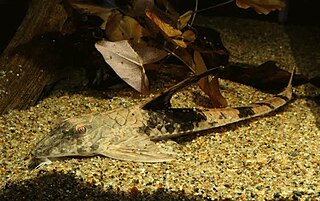
Loricariidae is the largest family of catfish, with over 90 genera and just over 680 species. Loricariids originate from freshwater habitats of Costa Rica, Panama, and tropical and subtropical South America. These fish are noted for the bony plates covering their bodies and their suckermouths. Several genera are sold as "plecos", notably the suckermouth catfish, Hypostomus plecostomus, and are popular as aquarium fish.

Hypostomus is a genus of catfish in the family Loricariidae. They are native to tropical and subtropical South America. H. plecostomus is the popular freshwater aquarium fish formerly known as Plecostomus plecostomus. The taxonomic structure of the Loricariidae is still being expanded by scientists. Hypostomus is a highly species-rich and widely distributed catfish genus.
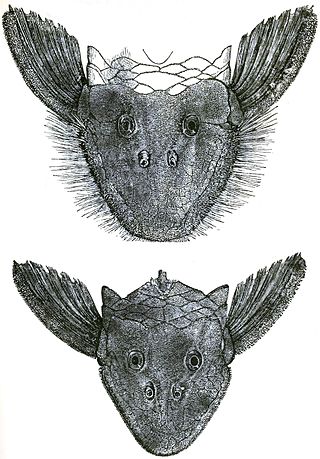
Pseudancistrus is a genus of suckermouth armored catfishes native to South America.

Hypancistrus is a genus of loricariid catfish originating from the Amazon basin in South America. Unlike many of the other Loricariids, however, some Hypancistrus species are more carnivorous and enjoy meat in their diet. Hypancistrus species are popular aquarium fish, including such popular fish as the zebra pleco and Queen Arabesque pleco.

Hemiancistrus is a genus of suckermouth armored catfishes. These species are native to South America. The taxonomy of this genus is complex and unclear, and major work has to be done. Many of these fish are popular aquarium fish.
Ancistomus is a genus of suckermouth armored catfishes found in shallow waters in rapidly flowing rivers in the southeastern Amazon basin in Brazil.

The Hypostominae are a subfamily of catfishes of the family Loricariidae. Most members are restricted to tropical and subtropical South America, but there are also several species in southern Central America. Hypostomus plecostomus, which is popular in the aquarium trade, has been introduced to several regions far from its native range.

Ancistrini is a tribe of catfishes of the family Loricariidae. Most are restricted to tropical and subtropical South America, but there are also several genus in southern Central America.
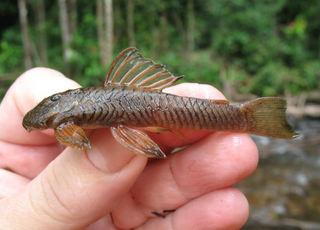
Guyanancistrus is a genus of suckermouth armored catfishes.
Peckoltia relictum is a species of armored catfish where it is found in the upper Marañon River in northern Peru.

Panaqolus is a genus of small catfish in the family Loricariidae native to rivers in tropical South America. Its members were formerly thought to belong to a clade of small-sized species in the genus Panaque, until this genus was separated from Panaque in 2001. At times it has been considered a subgenus of Panaque, and the validity of the genus has been disputed by various authors and sources. Pseudoqolus koko was formerly considered to be a member of this genus, although it was reclassified as a member of the currently monotypic genus Pseudoqolus by Nathan K. Lujan, Christian A. Cramer, Raphael Covain, Sonia Fisch-Muller, and Hernán López-Fernández following a 2017 molecular phylogenetic analysis.

Peckoltia sabaji is a species of catfish in the family Loricariidae. It is native to South America, where it occurs in the basins of the Rupununi, the Essequibo River, and the Takutu River in Guyana, as well as the basins of the Casiquiare canal, the Rio Negro, the Cinaruco River, and the Orinoco in Venezuela. It is usually found among boulders in medium to large rivers. The species reaches 19.8 cm SL and is of disputed classification.
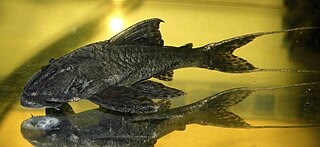
Peckoltia pankimpuju is a species of armored catfish from the family Loricariidae, native to the Marañón River in the upper Amazon basin of Peru. It is commonly called the coal pleco, Peruvian lyre-tail, and L350 under the L-number code. It reaches up to about 40 cm (16 in) in length.
Chaetostoma platyrhynchus is a species of catfish in the family Loricariidae. It is native to South America, where it occurs in the Caquetá River basin in Colombia. The species reaches 9.5 cm in total length. The species is known to be of disputed classification and spelling.
Hemiancistrus guahiborum is a species of catfish in the family Loricariidae. It is native to South America, where it occurs in the Orinoco drainage in Venezuela and Colombia. The species reaches at least 12.55 cm (4.94 in) SL and was described in 2005 by David C. Werneke and Jonathan W. Armbruster of Auburn University, Nathan K. Lujan of the American Museum of Natural History, and Donald C. Taphorn of the Royal Ontario Museum on the basis of its distinctive coloration and morphology. It appears in the aquarium trade, where it is usually known either as the orange-seam pleco or by its L-number, which is L-106.
Pseudoqolus koko is a species of catfish in the family Loricariidae and the only species in the genus Pseudoqolus. It is a freshwater fish native to South America, where it occurs in the Maroni basin. It is usually found on or near stony substrates in the main river channel at a depth of around 2 m. The species has been collected alongside multiple other loricariid species, including Hemiancistrus medians, Peckoltia otali, Pseudancistrus barbatus, Harttia guianensis, Loricaria cataphracta, and Rineloricaria stewarti. It is noted that the gut contents of one specimen of this species contained primarily spicules and sponge fragments, indicating that it may feed on freshwater sponges. The species reaches 9 cm SL.
Peckoltia cavatica is a species of catfish in the family Loricariidae. It is native to South America, where it occurs in the Rupununi basin in Guyana. It is found in areas with large amounts of lateritic rock, and it is usually seen in holes and caves within the rock, which are also where it is thought to breed. P. cavatica's preference for such environments was notable enough to the authors of its 2005 description, Jonathan W. Armbruster and David C. Werneke, that the specific epithet bestowed upon it means "living in caves" in Latin. The species reaches 7.2 cm SL.
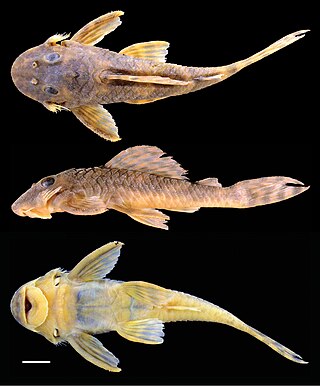
Peckoltia lujani is a species of catfish in the family Loricariidae. It is native to South America, where it occurs in the Orinoco and Meta River basins in Venezuela and Colombia. The species reaches 7.5 cm SL.
'Pseudancistrus' megacephalus is a species of catfish in the family Loricariidae. It is of uncertain and disputed classification.
Ancistomus spinosissimus is a species of catfish in the family Loricariidae. It is a freshwater fish native to South America, where it is known only from the upper and middle Tocantins River basin in Brazil. The species reaches 12.7 cm in standard length. Although originally described as a species of Hemiancistrus in 2003, a 2015 review conducted by Jonathan W. Armbruster, David C. Werneke, and Milton Tan listed the species as valid within Ancistomus. The same review also reported that no characteristics were found to separate A. spinosissimus from its congeners A. micrommatos and A. spilomma, indicating that the three may actually all be the same species.















